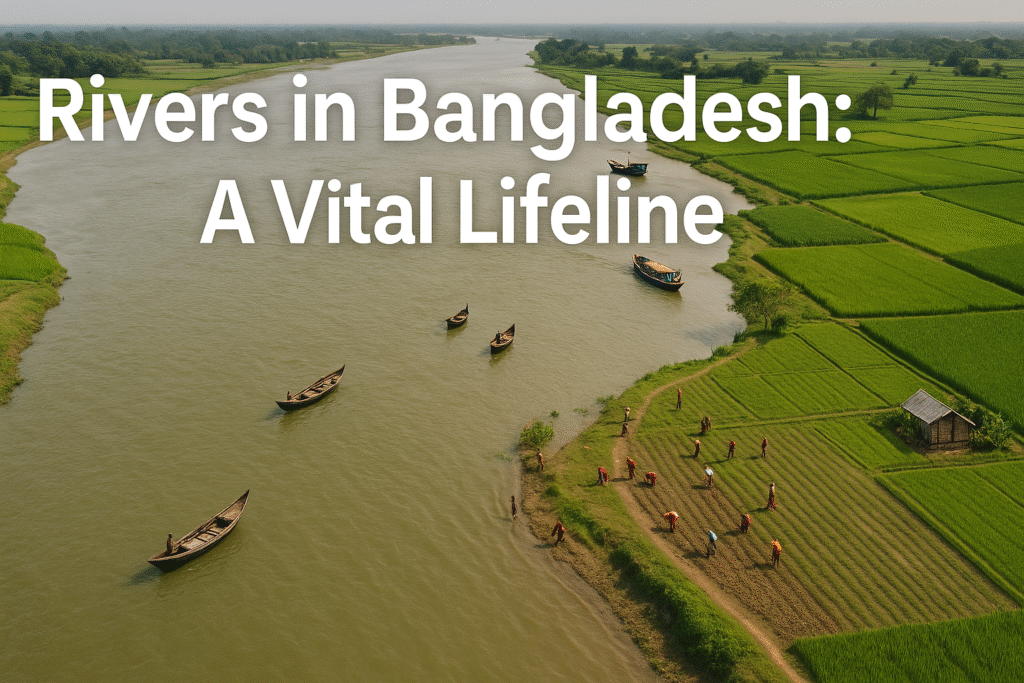Rivers in Bangladesh are more than water channels. They are the veins that keep the country alive. With over 700 rivers and tributaries, Bangladesh has one of the largest river networks in the world. These rivers form the Ganges-Brahmaputra-Meghna delta, the biggest in the world, covering nearly 80 percent of the country’s surface area.
According to the Bangladesh Bureau of Statistics, more than two-thirds of the population depends directly on rivers for agriculture, fisheries, transport, and livelihoods. From fertile soil to inland navigation, rivers are at the core of Bangladesh’s identity. The FAO reports that rivers and floodplains contribute over 60 percent of the country’s food production.
This blog explores how rivers sustain Bangladesh’s people, culture, and economy while highlighting the urgent need for their protection.
Rivers as the Backbone of Agriculture
Agriculture employs nearly 40 percent of Bangladesh’s workforce, and rivers are its foundation. The fertile alluvial soil deposited every year during floods makes the delta one of the most productive agricultural regions in the world.
Rice, the staple food of Bangladesh, relies heavily on river irrigation. The Bangladesh Water Development Board estimates that around 70 percent of irrigation water comes from rivers. Crops like jute, sugarcane, and vegetables thrive on floodplain fertility. Despite the risks of seasonal flooding, these river-fed lands ensure food security for over 170 million people.
Rivers and Fisheries: Feeding Millions
Rivers are the lifeline of Bangladesh’s fisheries. According to the Department of Fisheries, inland capture fisheries contribute over 40 percent of total fish production, and most of it comes from rivers and floodplains. Fish is not just a food item but a major source of protein for the population.
Nearly 12 percent of the population depends on fishing for their livelihoods. Popular fish species like hilsa, carp, and catfish breed in rivers and migrate to floodplains during the monsoon. The hilsa alone contributes 12 percent of total fish production and earns Bangladesh millions in exports each year.
Rivers as Highways of Transport
Bangladesh has 24,000 km of rivers and canals, making water transport a natural choice. Out of this, 6,000 km remain navigable year-round. According to the Bangladesh Inland Water Transport Authority (BIWTA), around 25 percent of the population uses river routes daily.
Goods transportation also depends on rivers. Jute, rice, coal, and construction materials are moved more cheaply by boats and ferries than by road. Major ports like Chattogram and Mongla rely on rivers for connectivity, making inland waterways vital to both domestic trade and international exports.
Rivers and Industry
Rivers play a direct role in industrial development. Many textile, garment, and tannery factories are located near rivers for access to water transport and production needs. However, this has created environmental challenges due to untreated industrial waste being discharged into rivers.
Still, industries like shipbuilding, sand mining, and river tourism depend on healthy waterways. According to the Export Promotion Bureau, shipbuilding has emerged as a billion-dollar industry, fueled by river access. River cruises and eco-tourism in the Sundarbans also attract foreign visitors, boosting the service sector.
Daily Life and Culture Along Rivers
For millions of rural people, rivers remain central to daily life. Families use river water for drinking, bathing, and cooking. In many villages, boats are still the only means of transport. Rivers are also deeply tied to culture. Bengali songs, poetry, and folklore often celebrate rivers as symbols of life and inspiration. Festivals such as boat races (nouka baich) draw thousands of spectators each year.
Economic Value of Rivers
The economic contribution of rivers is immense. According to a report by the World Bank, Bangladesh’s inland water transport system handles over 50 percent of cargo transport and 25 percent of passenger transport. Agriculture and fisheries combined contribute nearly 20 percent of GDP, most of it sustained by rivers.
Rivers also support hydropower. The Kaptai Dam in Rangamati produces 230 MW of electricity, a small but important share of national energy. With better planning, rivers could play a bigger role in renewable energy through micro-hydro and floating solar projects.
Challenges Facing Bangladesh’s Rivers
Despite their importance, rivers in Bangladesh are under severe threat. Pollution, encroachment, and upstream water withdrawal are reducing river health. The Buriganga, Turag, and Shitalakkhya rivers near Dhaka are among the most polluted in the world due to untreated industrial waste.
Climate change is another challenge. Rising sea levels are causing salinity intrusion in southern rivers, threatening agriculture and fisheries. Moreover, transboundary rivers face reduced flow due to upstream dams and diversions in India and China.
Solutions for River Conservation
Saving Bangladesh’s rivers requires urgent action. Strict enforcement of environmental laws is needed to stop industrial pollution. Investment in river dredging and restoration projects is vital to keep waterways navigable.
Community involvement is equally important. Local groups can help monitor illegal encroachment and pollution. International cooperation on transboundary rivers, especially the Ganges and Teesta, is also crucial.
Green infrastructure, such as wetlands and river buffers, can help restore ecological balance. Promoting eco-tourism and river-based education will also encourage citizens to value and protect rivers.
Rivers and the Future of Bangladesh
The future of Bangladesh depends on its rivers. Without healthy rivers, agriculture, fisheries, transport, and daily life would collapse. Protecting rivers is not only an environmental issue but also an economic and cultural necessity.
If properly managed, rivers could help Bangladesh achieve sustainable growth, ensure food security, expand renewable energy, and strengthen its cultural identity. In short, the survival of Bangladesh as a delta nation depends on the survival of its rivers.
